Must Reads: Five years after a massive fire near Yosemite, political ‘miracle’ erodes as Trump demands more logging

A look into the devastation caused by the Rim fire in 2013 and replanting the forest.
- Share via
Reporting from BUCK MEADOWS, Calif. — The Rim fire in 2013 brought devastation to a vast swath of Sierra Nevada forests west of Yosemite National Park. But the third largest wildfire in state history also seemed to have worked a political miracle, at least for a while.
In the aftermath of the blaze, environmental organizations, timber interests, state officials and the U.S. Forest Service buried decades of discord to forge an ambitious restoration and reforestation plan.
Its centerpiece is a federally funded community and watershed resilience program touted as a model for helping small town economies and wildlife habitats bounce back after wildfires throughout the western United States.
But now, five years after the fire, there is growing concern that the grand partnership is crumbling due to delays, frustration and a tug-of-war between preservationists and logging advocates backed by the Trump administration.
Growing tensions center on the role of logging and reforestation activities in and around the fire’s footprint. In the immediate aftermath of the blaze, logging companies removed 135 million board feet of marketable timber from public lands within the burned area.
Since then, the Trump administration has raised annual timber production targets for the Stanislaus National Forest region higher than they’ve been in decades.
Timber production on California’s public lands has been in steady decline since the 1980s. The Trump administration is trying to reverse that trend with new logging goals. The timber target for the area including Stanislaus, Sequoia and Sierra national forests for 2018 is 80 million board feet, up from 75 million board feet the year before, Forest Service officials said.
The growing role of industry is welcomed by the Forest Service, which sees timber harvesting and salvage logging as cost-effective strategies for reducing risks of future fires. The service spends about half of its $5-billion budget preparing for and suppressing wildfires on the 193 million acres of land it manages across the U.S.
Conservationists are disappointed by the meager progress in restoring and reforesting the Rim fire area.
But some environmental activists, opposed to timber interests and skeptical of reforestation activities, are celebrating the delays, which they believe are allowing the forest to regenerate naturally.
“Our fragile coalition is struggling for survival amid bureaucratic red tape, preservationists and the inefficiencies of the Forest Service,” said John Buckley, executive director of the nonprofit Central Sierra Nevada Environmental Resource Center. “But it’s still hanging together. The resilience of our public forest depends on our support.”
“It’s unfortunate there isn’t more trust,” he said.
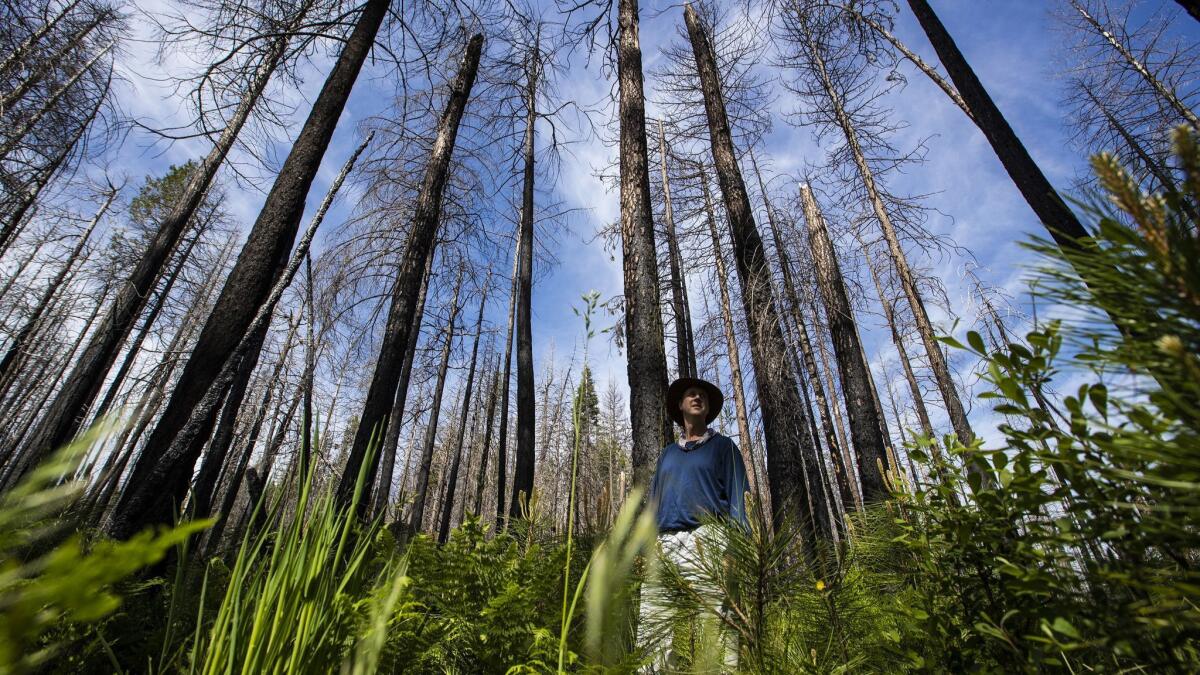
Critics blame complex funding requirements and protests from environmental activists for delays in accessing a $70-million U.S. Housing and Urban Development grant awarded to the state Department of Housing and Community Development to pay for post-fire projects.
The grant would cover construction of a biomass cogeneration facility that would burn dead trees for energy and the costs of reforesting 25,000 acres of High Sierra wilderness deemed scorched by the U.S. Forest Service.
So far, only about 1,700 acres have been replanted in the Stanislaus. Some of those areas are thriving. In others, however, most of the seedlings expected to jump-start new generations of conifers have shriveled up and died.
While that slow progress has riled environmentalists, some in their ranks have quietly cheered the sluggish pace of restoration projects in the Rim fire area because they want to see the ecosystem rebound on its own.
They are threatening legal action to safeguard habitat and endangered creatures that scientists say have low tolerance for the clatter of crews with chain saws and big-rig trucks: spotted owls and a geographically isolated and genetically distinct clan of about 200 great gray owls — the largest owl in America.
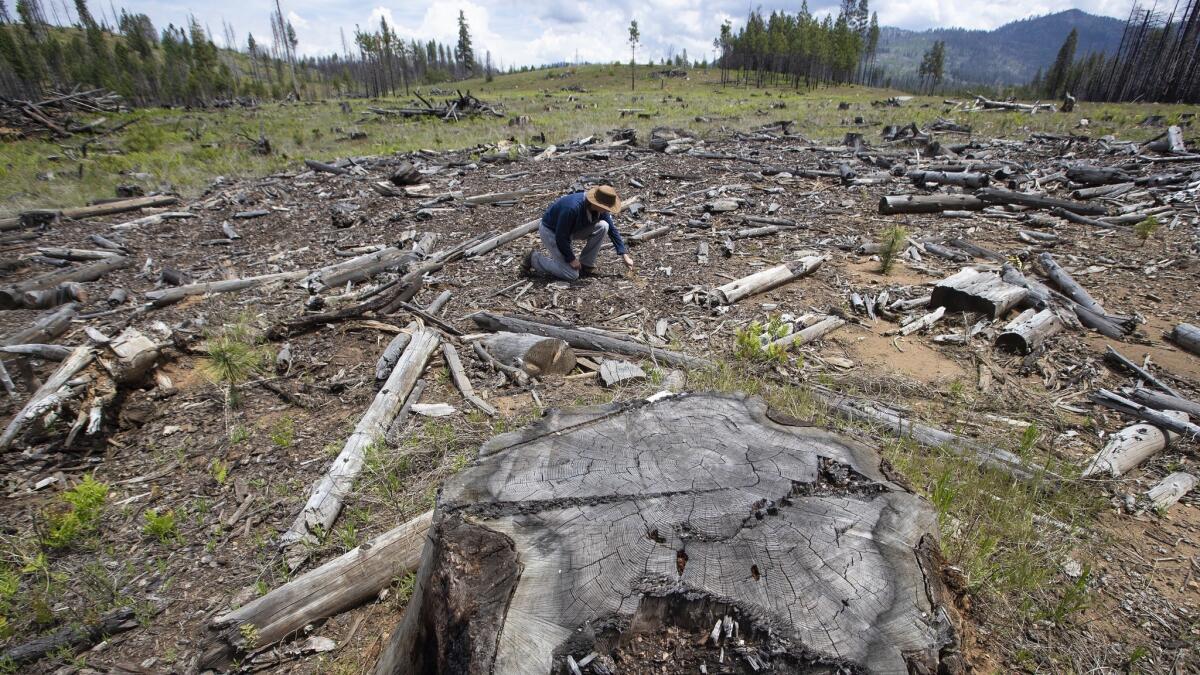
“Using the HUD grant to fund reforestation projects will only contribute to the degradation of natural forest habitat — not its regeneration,” said Chad Hanson, a research ecologist with the John Muir Project. “Reforestation is a political tool to facilitate more logging.”
That kind of talk leaves some federal forest managers and timber industry advocates quietly seething.
Modern forestry techniques, they say, can accommodate harvesting, thinning of fuel loads and tree-planting without destroying wildlife habitat.
As for scientific studies suggesting that endangered owls would abandon their nests, Jim Junette, a district ranger in the Stanislaus, assured, “They’ve adapted to disturbance.”
Beyond that, he said, salvage logging, brush removal and reforestation projects are needed to manage fuel loads in a region scarred by 20 large blazes since 1944.
The Forest Service’s budget has shrunk by about $1.5 billion over the last two years. At the same time, commercial activity on public lands has increased.
Most of the money from timber sold by the Forest Service goes to the U.S. Treasury. A portion is set aside to cover administrative costs and to help pay for civic amenities such as roads and schools in counties with overlapping jurisdictions, officials said.
Some proceeds of salvaged timber sales fund federal reforestation, such as those that followed the Stanislaus Complex fire in 1987. Millions of pine trees planted after that blaze were consumed by the Rim fire.
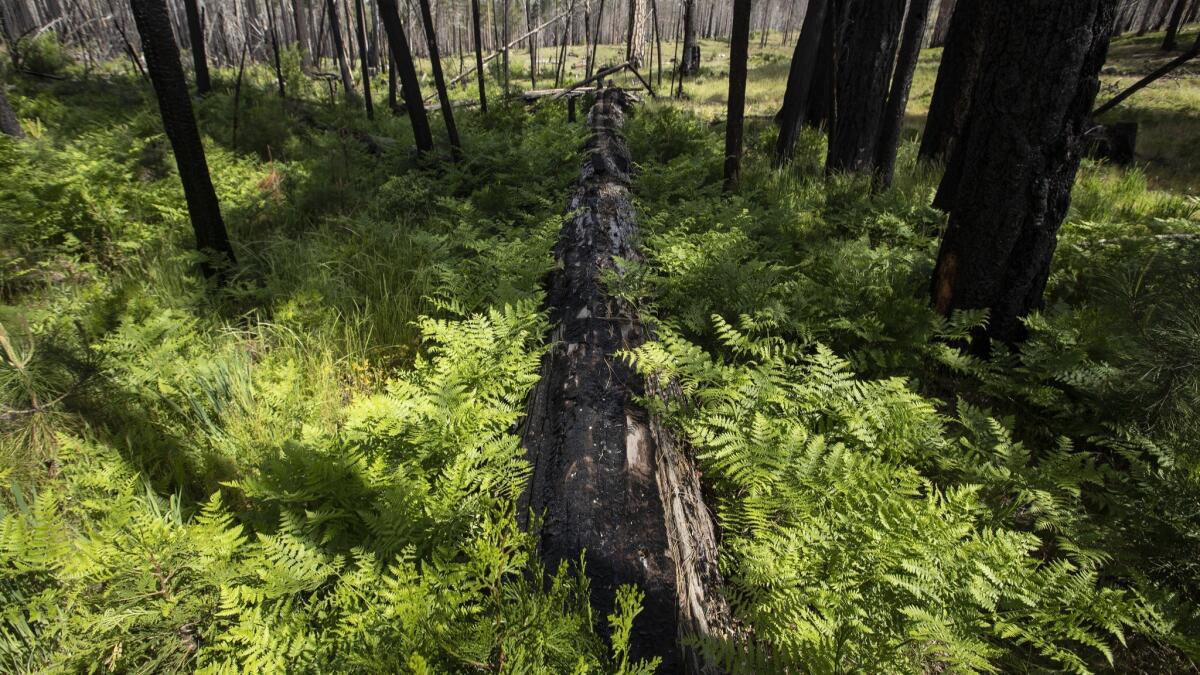
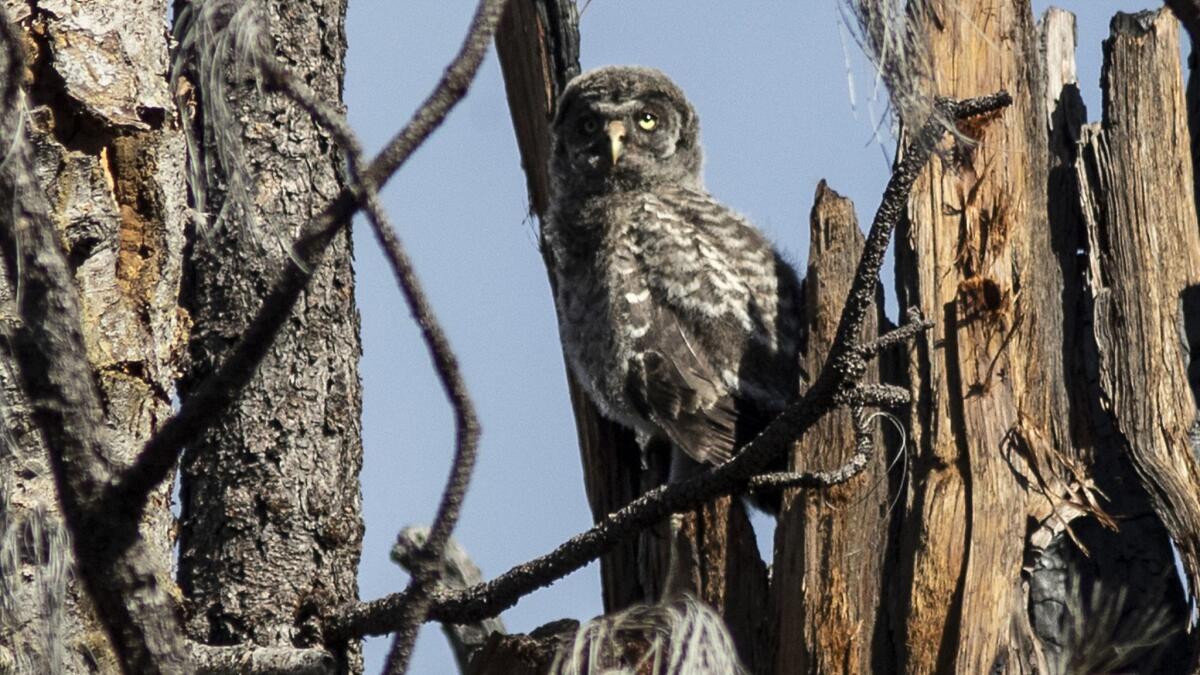
Under previous administrations, timber targets were assigned to individual national forests. The Trump administration has set timber goals for zones comprised of neighboring national forests.
That shift has made it it difficult to compare the timber output of a single forest over time. But Jason Kuiken, supervisor of the Stanislaus National Forest, acknowledges his team is “under pressure to get more wood out.”
“Our mission is to sustain the health, diversity and productivity of the nation’s grasslands and forests,” he said. “That goal is awesomely lofty and terribly difficult to attain. But if you don’t try, you’ll never succeed.”
Expediting timber production and restoration were main topics of discussion during an invitation-only tour of the Stanislaus in May led by Reps. Doug LaMalfa (R-Richvale) and Tom McClintock (R-Elk Grove). McClintock sees environmental laws as time-consuming and cost-prohibitive restrictions that have reduced timber harvests and left forests unnaturally dense and prone to disease and wildfire.
Guests included interim Forest Service Chief Vicki Christiansen; Stanislaus National Forest officials; representatives from Sierra Pacific Industries, the main logging company active in the Rim Fire area; and Malcolm North, a scientist at the Forest Service’s Pacific Southwest Research Station in Davis, Calif.
“The discussion mostly focused on increasing the pace and scale of fuel treatments in regions like the Stanislaus,” North recalled, “in hopes of reducing risks of large intensive fires and substantially increasing timber production.”
The exclusion of conservationists raised suspicions in some camps that administration policymakers and supporters in Congress are making decisions about what to cut and what to save — meaning trees and jobs.
“Politicians often use wildfire as an excuse to increase timber targets,” said Ray Rasker, executive director of Headwaters Economics, an independent, nonprofit research group.
Separate tours in June promoted clashing visions of the Rim fire area’s future: One showed off a plantation of thriving young pine trees, the other explored the regenerative pulses springing up years after a hunter’s illegal campfire consumed 257,000 acres.
“We spent two years planning how to restore this forest in a manner that serves everyone’s best interests,” Scott Tangenberg, the Stanislaus National Forest’s deputy forest supervisor, said at a site overlooking the canyon where the Rim fire broke out. “It’s been a great way to connect with the local community.”
For ecologist Hanson, who wants to see the forest left alone, a swath of dead standing and fallen trees blackened with soot was a sign of nature’s process.
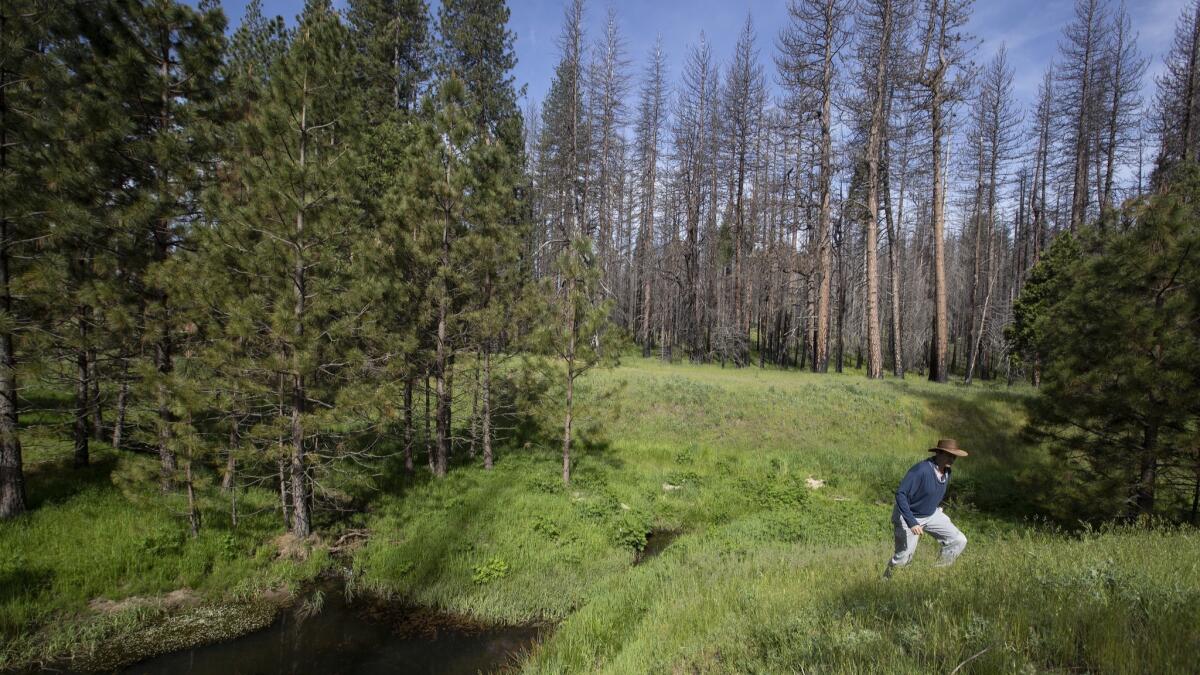
“What’s really going on here is an abundance of succession of forest growth and wildlife,” he said, admiring the landscape of knee-high ferns, Sierra Nevada wild irises buzzing with pollinators and young trees — ponderosa pine, incense cedar, white birch, sugar pine — shooting up among the charred snags.
With the snags came black-backed woodpeckers, candidates for listing under the California Endangered Species Act. The woodpeckers play a key role in post-fire forest ecology by feasting on wood-boring beetles. In the process, they create nesting holes in snags for other birds and mammals such as Western bluebirds and squirrels.
Hanson’s John Muir Project is among 26 environmental organizations that on Tuesday formally requested the Sierra Nevada Conservancy halt logging and reforestation activities in the Rim fire area pending further scientific analysis of their potential effects on biodiversity. The state agency is working with the Forest Service to help divvy up the $70 million in federal funding.
Suddenly, Hanson came to an abrupt halt and signaled for silence as he scanned the tree tops.
“There!” he said, his eyes fixed on a tell-tale shape in a snarl of skeletal limbs 100 feet above the forest floor.
Staring back at him was a fledgling great gray owl with a 4-foot wingspan and piercing yellow eyes accented by facial discs, one of five owls in a recently discovered nest less than two miles from an area targeted for intensive logging.
“The young owls will be depending on their parents for another four months before establishing their own territories,” Hanson said. “Logging and reforestation in the name of recovering allegedly ‘wasted’ forest land here is not going to happen if we can help it.”
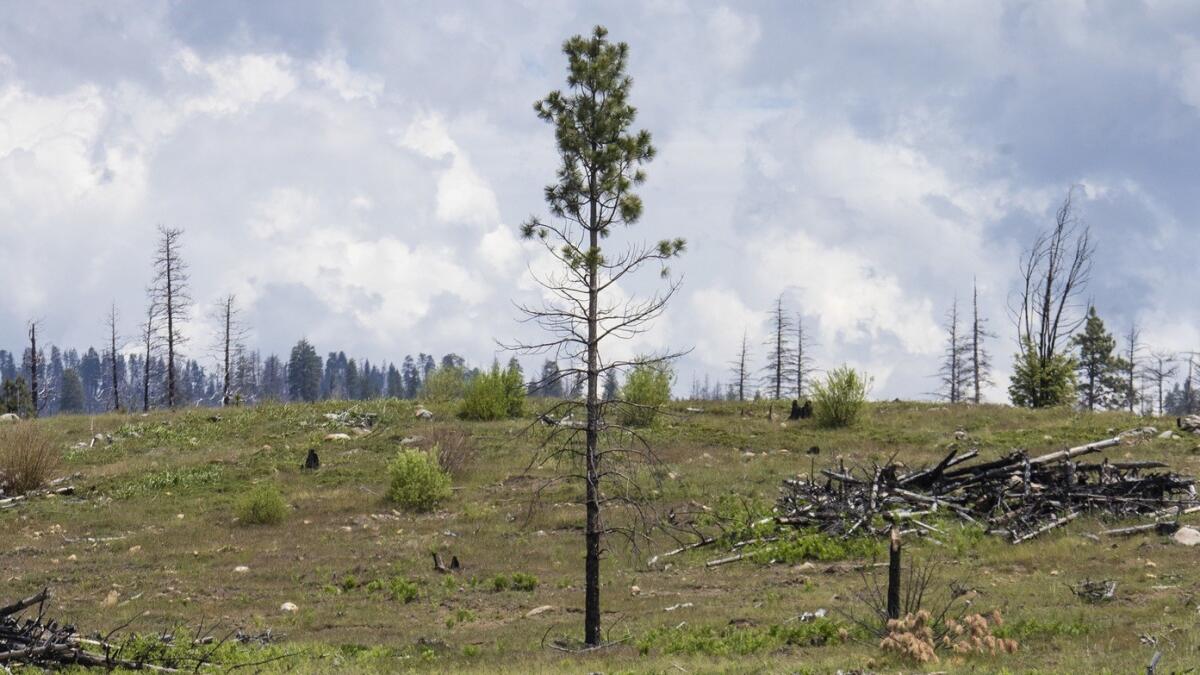
More to Read
Sign up for Essential California
The most important California stories and recommendations in your inbox every morning.
You may occasionally receive promotional content from the Los Angeles Times.











